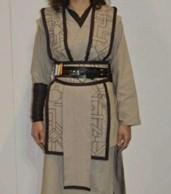Embellishments
Trim
If desired, decorative trim can be applied to the outer edges, or be slightly inset and run along the edge, of the tabards and obi, and to the hem, sleeve edge, and collar band of inner and outer tunics. Trim can also run down the center of tabards or obis. Trim must be no more than 1” (2.5cm) in width, unless it is being used on the neck band of the outer tunic, in which case it can be the entire width of the neck band. Trim must be neatly applied, and uniform in width.
There can only be one additional color of trim added in a costume, which must be one of the primary, secondary, or trim colors for the appropriate faction. Trim can also be a color which is used in another part of the costume.
Geometric Shapes
Geometric abstractions (circles, squares, straight lines that form a pattern, triangles etc) can be used within trim for both tunics and tabards. Designs should be similar to what appears in Star Wars. Designs can be inspired by real world cultural designs, but should not mimic the design. Celtic Knotwork, Kanji, Norse runes, or similar easily identifiable cultural designs will be rejected for being too earth-bound. Designs should be pre-approved by the GCCs.
While ribbon can be used for trim, it needs to be matte in appearance. Further application methods are outlined in the other embellishments section of this document.
This trim should still follow the same width requirements of trim and should follow color rules for the appropriate faction of the character.
Decorative Topstitching
In place of trim, decorative topstitching can be added to the same places where trim is allowed. Topstitching must be in a simple stitch pattern, such as straight stitch or zigzag stitch; any other stitch patterns should be pre-approved by the GCCs. It must be neatly done so that the stitching is uniform, straight, and an even distance from the edge of the garment.
Topstitching must follow the same color rules as trim, and cannot be done with metallic or other shiny thread.
Weathering
Weathering for Saber Guild kits should be used to show that a kit has been used in the elements in the universe of Star Wars. Weathering should be a design choice and not used to justify wear on one element of a costume, unfinished construction, or dirty and unwashed pieces. Weathering should be consistent throughout the costume; one piece should not be significantly more weathered than the rest. Fabric pieces can be frayed around the edges, showing thinning of fabric in places of high friction, or discolored from use. Leather pieces can be discolored or rough in places with high friction. All parts of the costume must still be present, and all requirements to fit still apply. Work with your LCC and the GCCs through the weathering process to ensure that your costume is not over-weathered.
Light to moderate weathering is allowed for Jedi, and more extensive weathering is allowed for Sith.
Other Embellishments
Designs on fabric should look like a Star Wars Universe design and should only be used for the tabard/obi. All designs other than those listed above should be pre-approved by the GCCs before construction begins. Please supply the Consulars with reference when adding design to your fabric. If you create your own designs on fabric, make sure your lines are clean, well defined, and that the fabric underneath the design isn’t visible. Fabric paint can be used, though it should be dark enough that it stands out, and that the design is clear. Applique is also encouraged, and embroidery will help give the design more definition and depth.
Beading, or inking may also be used to add details to the tabards. Jedi designs for stitching, embroidery, or beading should not be gaudy or flashy to show expense. Jedi costumes are modest and humble and are not traditionally extravagant (no bedazzling). Sith embellishments may be slightly more flamboyant, but are still expected to be reasonably unobtrusive. Embellishments must fit into the Star Wars universe. As such, they must not look gothic medieval, or earthbound in design. Designs are strongly recommended to be geometric and must not contain a floral pattern. No heraldry markings are permitted (i.e., Sith Sun, Jedi symbol, Imperial Cog, First Order Black Sun, or any animals).


